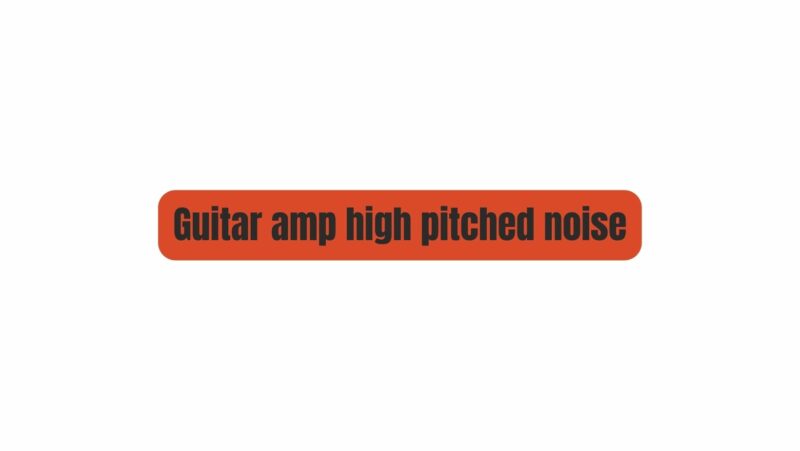Guitar amplifiers are the heart and soul of a guitarist’s sound, serving as the conduit through which their sonic expressions come to life. However, amidst the harmonious tones they produce, guitar amps can sometimes introduce an unwelcome guest – a high-pitched noise. This piercing, screeching sound can be frustrating and perplexing for guitarists. In this article, we will explore the world of high-pitched noises in guitar amplifiers, unraveling their origins, the factors that contribute to them, and providing practical solutions for diagnosis and resolution.
Understanding the Basics: How Guitar Amps Work:
Before we dive into the causes and solutions of high-pitched noises in guitar amps, let’s establish a basic understanding of how these amplifiers function:
- Amplification Process: Guitar amplifiers are designed to take the low-level audio signal from your guitar and boost it to a level that can drive a speaker, producing sound that is audible to an audience.
- Components of a Guitar Amp: A typical guitar amplifier consists of an input stage, preamplification stage, power amplification stage, and a power supply. These components work in harmony to amplify the audio signal.
- Signal Path: The audio signal from your guitar flows through the amplifier, undergoing various stages of amplification and tonal shaping before reaching the output stage, which ultimately drives the speaker.
The Intriguing High-Pitched Noise: Common Causes:
High-pitched noises in guitar amplifiers can be an unwelcome distraction during your playing sessions or live performances. Let’s explore some common sources of these noises:
- Electromagnetic Interference (EMI): EMI can infiltrate the amplifier through unshielded cables or poorly insulated internal components. This interference often manifests as a high-pitched whine, squeal, or feedback.
- Microphonic Tubes: In tube amplifiers, vacuum tubes can act as microphones, picking up mechanical vibrations and translating them into audible noise. When a tube becomes microphonic, it may produce a high-pitched ringing sound.
- Feedback Loops: High-pitched noises can result from feedback loops within the amplifier’s circuitry. These loops can occur due to improper connections, component failures, or circuit design issues, leading to squealing or screeching.
- Power Supply Issues: Irregularities in the power supply, such as voltage fluctuations or inadequate filtering, can introduce noise into the audio signal path, resulting in high-pitched tones.
Diagnosing the High-Pitched Noise: Identifying the Source:
To effectively address high-pitched noises in your guitar amplifier, it’s crucial to identify their source. Here’s a systematic approach to diagnosing the problem:
- Isolate the Amplifier: Disconnect any external effects pedals, footswitches, or other devices from your amplifier. This helps determine if the high-pitched noise originates within the amplifier or is introduced from external sources.
- Swap Cables: Replace the guitar cable connecting your guitar to the amplifier with a high-quality, shielded cable. If the noise disappears or changes, it’s likely that the original cable was picking up interference.
- Inspect Vacuum Tubes: In tube amplifiers, gently tap each tube with a non-metallic object while the amplifier is on. If tapping a specific tube produces or changes the high-pitched noise, that tube may be microphonic and in need of replacement.
- Check for Feedback Loops: Investigate the amplifier’s circuitry and connections for signs of feedback loops. Ensure that all components are properly connected and functioning as intended.
- Power Supply Analysis: Use a multimeter to measure the voltage at the amplifier’s power input terminals while the amplifier is on. Check for voltage fluctuations or irregularities that could be contributing to the noise.
Addressing High-Pitched Noise: Solutions and Best Practices:
Once you’ve identified the source of the high-pitched noise, you can take appropriate steps to address it. Here are some solutions and best practices:
- High-Quality Cables: Invest in high-quality, shielded audio cables for your guitar and effects pedals. Shielded cables help minimize EMI interference and ensure a clean signal path.
- Tube Replacement: If you’ve identified a microphonic tube as the source of the high-pitched noise in a tube amplifier, consider replacing that tube with a new, high-quality one.
- Feedback Loop Mitigation: Address any feedback loops within the amplifier’s circuitry through proper connections and circuit design. Consult an experienced technician or amplifier specialist if necessary.
- Power Conditioning: Use a power conditioner or surge protector to filter out electrical noise and provide clean, stable power to your amplifier.
- Noise Gates: Consider using a noise gate pedal in your signal chain to suppress unwanted noise when you’re not playing. This can be especially helpful for taming feedback.
- Professional Assistance: If the high-pitched noise persists or if you’re uncomfortable with DIY troubleshooting, seek the expertise of a qualified guitar amplifier technician or specialist.
Conclusion: Harmonizing Your Guitar Amp’s Sound:
High-pitched noises in guitar amplifiers may momentarily disrupt your musical journey, but with systematic diagnosis and the application of appropriate solutions, you can enjoy the pristine sound quality you desire. Whether it’s addressing interference, resolving tube issues, or optimizing your signal chain, the key lies in understanding the causes and employing the right strategies. Embrace the challenge of unraveling the screech, and let your guitar amplifier once again be the conduit for the captivating melodies and sonic expressions that define your musical identity.

